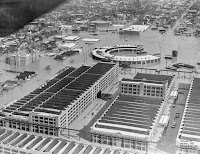Today
most people think of Paducah as a river town because its location is where the
Tennessee River flows into the Ohio River, just a few miles east of where they
will jointly meet up with the Mississippi River. With flat boats and then steamboats
the river was a major throughfare of pioneer America. What people don’t know is
that it was also a key city in the early days of railroading – Paducah Gateway covers
that history.
Both
sides of the Ohio River had dozens of short line railroads moving people,
agricultural commodities, timber, and coal, lots and lots of coal. In the book
author Donald Lessley puts all of that in a roughly chronological order with failures
and mergers eventually narrowing the railroad companies down to basically the
Illinois Central Gulf, the Burlington Northern, and the (Norfolk) Southern RR –
all three are still active. They faced a common challenge however, getting across
the river: to the north with an end goal of Chicago; and to the south with an
end goal of either New Orleans or Mobile. Hence, Paducah, KY with its
established ferry to Brookport, IL became a key transfer point. Today it is
hard to imagine, but before bridges trains were decoupled and placed on ferry boats,
three or four cars at a time, and then recoupled on the other side. The time!
The expense!
Importantly,
the IC (Illinois Central) owned and profited from that ferry. When later the IC
was asked to join with other lines to build a two-track rail bridge across the river
at Metropolis, they declined. They would later have to lease access to the bridge when
it opened in 1917.
Although that decision was questionable, the IC would turn Paducah into a rail hub by building its
repair shop there, growing the small city into an IC “factory town” employing thousands
in what would evolve into a massively large building complex and roundhouse –
steam engines needed regular maintenance. The expertise developed at the
complex would result in not only the IC but also other rail lines sending their
engines to Paducah. When the entire industry turned from Steam power to Diesel
power, the shop turned with it. But diesel engines required far less maintenance
resulting in a significant downsizing of operations over the years.
Perhaps the most interesting of the chapters in the book deals with the Ohio River flood of 1937, the worst in the city's history and before the city's reknowned flood walls had been completed. With a 60 foot crest, it impacted railroading (and everything else) particularly the maintenance complex & round house.
Today the former complex is one of the City of Paducah's major urban renewal challenges, what to do with these huge, mostly vacant buildings.Passenger traffic declined locally as it did everywhere else in the country as a result of America’s love affair with the automobile. All local stops except for the IC’s iconic City of New Orleans train, now operated by Amtrak, were eliminated, and it only has a flagged stop in Fulton, KY, passing by at 3 in the morning.
Mr.
Lessley’s book contains extensive reference material, far more than my
oversimplification can relate. History buffs would benefit from it, and railroad
buffs will love it. I bought my copy at Paducah’s Railroad Museum.
Recommendation:
I liked it, but I’m both a history and railroad buff, not to mention I live in
Paducah.



